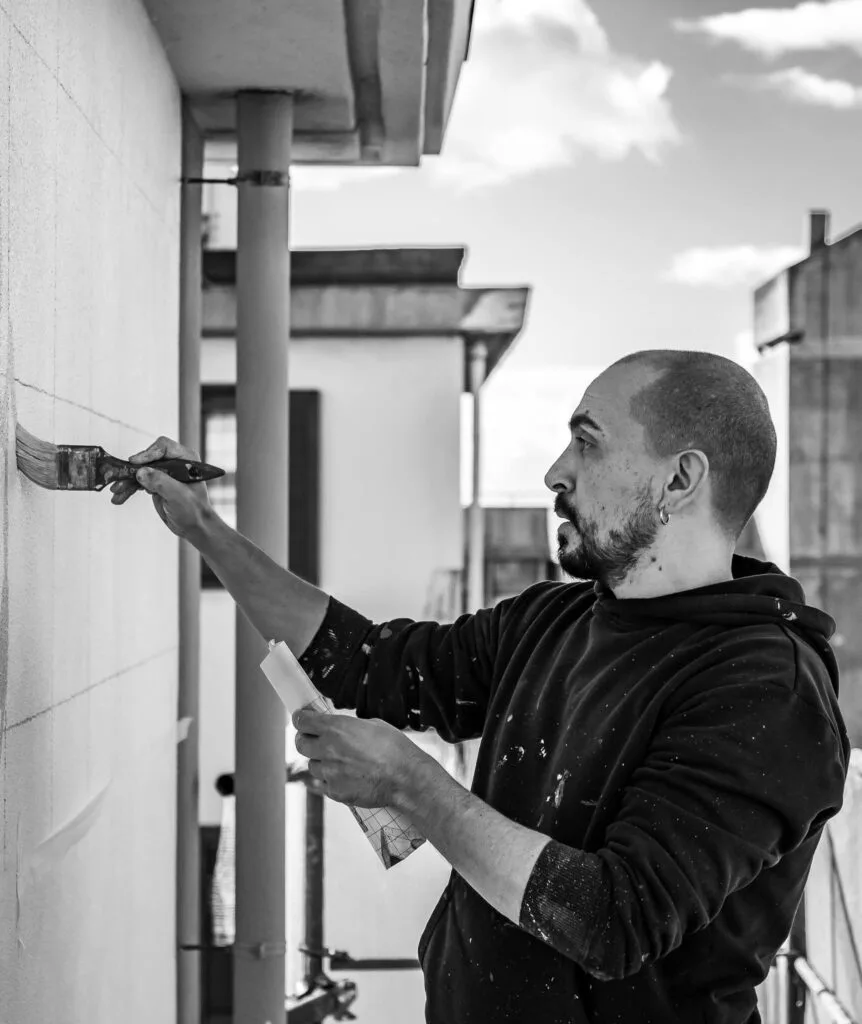
His style is unmistakable: fragments of Sardinia reimagined with a contemporary touch. Threads of clothing, faces, and decorative elements define the time and place of his mural work.
He is Mauro Patta, an artist from Atzara, a land of wine, sun-kissed rolling hills, and vineyards, a land that has long welcomed painters and poets.
It is from this world, rich in color and light, that Mauro draws inspiration to tell the story of Sardinia, to reveal, through murals, the essence of place: its history, its colors, its craftsmanship, and to offer us beauty and meaning.
In an era shaped by technological ease, by dull replicas of reality, and by the endless and pointless repetition of scenes from a bygone era, where the superficial and the ugly often prevail, true art, the kind of genius that has something to say, stands out all the more clearly.
You won’t walk past Mauro Patta’s murals distractedly or in haste; you’ll stop, captivated by his faces and absolute colors, because real art suspends the everyday and the noise, creating a moment of silence and tension between beauty and what it represents.
Mural art is democratic: it knows no museum walls for shelter; it lives under the open sky, exposed to time and to the gaze of all. Mauro Patta’s street art goes beyond simply revitalizing spaces or embellishing places, it transforms vast walls into shared and inclusive visions, offering everyone, without distinction, an imaginary both ancient and new, both powerful and poetic.
Mauro Patta’s works can be found on the walls of various towns across Sardinia, but also in Sicily, France, and Russia. Seek them out and get lost in the faces, the weaves of garments and tools, in the brushstrokes of color and perfect geometry, where beauty resides, and with it, a soul of the island that is never trivial and never reduced to folklore.

Mauro, tell us a little about yourself: how did your passion begin? Was it something you felt as a child, or did it develop over time?
I’ve had a passion for painting since I was a child. When the teacher would ask, “What do you want to be when you grow up?” my answer was always, “I want to be a painter.” I was always drawing with pencils, and the older I got, the more time I dedicated to drawing.
Then I attended art high school, and from there I began exploring painting as a medium. I refined my technique over time, first by studying at the Academy of Fine Arts in Florence and later working as a porcelain painter at the Richard Ginori factory in Sesto Fiorentino.
How important is Atzara to your art?
Atzara means a lot to me. After all, this is where my journey as a muralist began.
Why do you devote yourself to mural art? What does it mean to you?
I got into muralism after winning a competition in Atzara, and I fell in love with that form of art.
First of all, the philosophy of creating art that is accessible to everyone is fascinating, it’s the complete opposite of the traditional artist-gallery-client relationship.
Here, there’s a direct dialogue with the viewer, and that dialogue begins even before the work is finished.
Another fascinating aspect of muralism is the opportunity to work on a large scale. Every time, it’s a challenge for me.
Does mural art carry a collective meaning?
One of the most important functions of muralism and street art is urban regeneration. As an artist, I feel a responsibility to make a place more beautiful than it was before, especially for the people who live there every day.
You express “Sardità” (Sardinian identity, its traditions, clothing, etc.) in a modern way: ancient and contemporary, dressed in elegance.
Sardinian culture is incredibly rich and has so much to offer an artist. For me, it’s a constant source of inspiration. But I’m a child of my time, so I try to express that culture using a contemporary language.
The decorative elements are really important in your work, they’re almost like a signature.
That decorative, graphic side likely developed during my time working at the Richard Ginori porcelain factory. I like using that kind of detail not just for its aesthetic value but also because it can strengthen the personality of a piece, making it more delicate, or on the other hand, more bold and direct.
Another key element is composition, which is always thoughtful and very elegant.
Composition is fundamental. It always starts with the shape of the wall itself. The same theme can be told in completely different ways depending on the surface. Composition is another powerful tool for conveying the character of a piece.
What was your first mural?
My first mural, as I mentioned, was in Atzara in 2014, after I won a competition. I titled it Maternity, and it depicts a woman in traditional dress holding a bunch of grapes, to reflect the area’s winemaking heritage, a local traditional sweet, and a paintbrush, representing Atzara’s long-standing connection with both local and international artists.
What are you working on now? What projects do you have coming up?
Right now, I’m creating a mural in Esterzili, dedicated to the Domu ‘e Urxia temple. I always have several projects in the works, each at different stages: some in the sketching phase, others in planning, and so on.
Author: Lucia Cossu.
Translated by Emanuele Mulas. Originally published in Italian on Officina Progetti. Read it here “L’arte muraria di Mauro Patta: tra bellezza e significato”


